A New Strategy for the Prevention and Control of Eupatorium adenophorum under Climate Change in China
Abstract
:1. Introduction
2. Materials and Methods
2.1. Species Records
2.2. Environmental Input Variables
2.3. Environment Variables Analysis and MaxEnt Modelling
2.4. Depicting the Invasive Route of E. adenophorum
3. Results
3.1. Selection of Environment Variables
3.2. The Potential Distribution of E. adenophorum in China
3.3. Center Displacement of Different Distribution Levels
4. Discussion
4.1. Selection of Environment Variables and Prediction of Potential Distribution
4.2. Prevention and Controlling Strategies
Acknowledgments
Author Contributions
Conflicts of Interest
References
- Liu, J.; Dong, M.; Miao, S.L.; Li, Z.Y.; Song, M.H.; Wang, R.Q. Invasive alien plants in China: Role of clonality and geographical origin. Biol. Invasions 2006, 8, 1461–1470. [Google Scholar] [CrossRef]
- Li, Y.; Feng, Y. Differences in Seed Morphometric and Germination Traits of Crofton Weed (Eupatorium adenophorum) from Different Elevations. Weed Sci. 2009, 57, 26–30. [Google Scholar] [CrossRef]
- Sang, W.; Zhu, L.; Axmacher, J.C. Invasion pattern of Eupatorium adenophorum Spreng in southern China. Biol. Invasions 2010, 12, 1721–1730. [Google Scholar] [CrossRef]
- Yu, X.; Yu, D.; Lu, Z.; Ma, K. A new mechanism of invader success: Exotic plant inhibits natural vegetation restoration by changing soil microbe com-munity. Chin. Sci. Bull. 2005, 50, 1105. [Google Scholar] [CrossRef]
- Sun, X.; Lu, Z.; Sang, W. Review on studies of Eupatorium adenophorum an important invasive species in China. J. For. Res. 2004, 15, 319–322. [Google Scholar] [CrossRef]
- Shen, J.; Li, X.; Wang, D.; Lu, H. In Vitro Culture of Croftonweed (Ageratina Adenophora): Considerable Potential for Fast and Convenient Plantlet Production. Weed Technol. 2007, 21, 445–452. [Google Scholar] [CrossRef]
- Zhu, L.; Sun, O.J.; Sang, W.; Li, Z.; Ma, K. Predicting the spatial distribution of an invasive plant species (Eupatorium adenophorum) in China. Landsc. Ecol. 2007, 22, 1143–1154. [Google Scholar] [CrossRef]
- Weber, E.; Sun, S.S.-G.; Li, B. Invasive alien plants in China: Diversity and ecological insights. Biol. Invasions 2008, 10, 1411–1429. [Google Scholar] [CrossRef]
- Ministry of Environmental Protection of the People’s Republic of China List of the First Batch of Alien Invasive Species in China. Available online: http://www.mep.gov.cn/gkml/zj/wj/200910/t20091022_172155.htm (accessed on 30 August 2017).
- Khonglam, A.; Singh, A. Cytogenetic studies on the weed species of Eupatorium found in Meghalaya, India. Proc. Plant Sci. 1980, 89, 237–241. [Google Scholar] [CrossRef]
- Wang, Y.; Fu, B.; Lü, Y.; Chen, L. Effects of vegetation restoration on soil organic carbon sequestration at multiple scales in semi-arid Loess Plateau, China. Catena 2011, 85, 58–66. [Google Scholar] [CrossRef]
- Wang, R.; Wang, Y.; King, S.R.; Eupatorium, H.R. Invasion dynamics and potential spread of the invasive alien plant species Ageratina adenophora (Asteraceae) in China. Divers. Distrib. 2006, 12, 397–408. [Google Scholar] [CrossRef]
- Zheng, Y.; Feng, Y.; Liu, W.; Liao, Z. Growth, biomass allocation, morphology, and photosynthesis of invasive Eupatorium adenophorum and its native congeners grown at four irradiances. Plant Ecol. 2009, 203, 263–271. [Google Scholar] [CrossRef]
- Zhao, Y.; Yang, X.; Xi, X.; Gao, X.; Sun, S. Phenotypic Plasticity in the Invasion of Crofton Weed (Eupatorium adenophorum) in China. Weed Sci. 2012, 60, 431–439. [Google Scholar] [CrossRef]
- Tian, M. Photosynthetic Ecophysiology of Crofton Weed During the Dry Season in the Dry Valley of Jinsha River and its Invasion Risks to Sichuan Basin. J. China West Norm. Univ. (Nat. Sci.) 2010, 31, 364–371. (In Chinese) [Google Scholar] [CrossRef]
- He, W.-M.; Li, J.-J.; Peng, P.-H. A Congeneric Comparison Shows that Experimental Warming Enhances the Growth of Invasive Eupatorium adenophorum. PLoS ONE 2012, 7, e35681. [Google Scholar] [CrossRef] [PubMed]
- Wang, F.; Summerell, B.A.; Marshall, D.R.; Auld, B.A. Inoculum production of Phaeoramularia, a potential mycoherbicide for crofton weed. Australas. Plant Pathol. 1997, 26, 173–178. [Google Scholar] [CrossRef]
- Global Biodiversity Information Facility (GBIF). Available online: https://www.gbif.org/ (accessed on 30 August 2017).
- Ni, W. Influences of Environmental Factors on the Seed Germination of Eupatorium adenophorum. Ecol. Sin. 1983, 3, 327–331. (In Chinese) [Google Scholar]
- Chang, Q.; Zou, R.; Fan, W.; Deng, Z.; Yi, M.; Hu, Y. An Exploratory Study on the Damage and Prevention Countermeasures of Eupatorium adenophorum. Guizhou For. Sci. Technol. 2005, 33, 47–49. (In Chinese) [Google Scholar]
- He, Y.; Nie, L.; Lu, D.; Ye, Z. Research Status of Controlling Eupatorium adenophorum. Guizhou Agric. Sci. 2005, 3, 50–52. (In Chinese) [Google Scholar]
- Lu, P.; Sang, W.; Ma, K. Progress and Prospects in Research of an Exotic Invasive Species, Eupatorium adenophorum. Chin. J. Plant Ecol. 2005, 29, 1029–1037. (In Chinese) [Google Scholar] [CrossRef]
- Wang, Y.; Zhao, B.; Fan, Z.; Fan, Y.; Tan, C. The Advance in Eupatorium adenophorum Spreng and Its Damage. Progress Vet. Med. 2005, 26, 45–48. (In Chinese) [Google Scholar] [CrossRef]
- Yin, J.; Ma, X.; Deng, J. Investigation on Harmful Bio-organisms of Grassland in Yunnan. J. Sichuan Grassl. 2005, 121, 19–23. (In Chinese) [Google Scholar] [CrossRef]
- Yin, J. The current status and outlook of Eupatorium adenophorum control in southwest China. Pratacult. Sci. 2006, 23, 82–85. (In Chinese) [Google Scholar] [CrossRef]
- Huang, W.; Guo, J.; Wan, F.; Gao, B.; Xie, B. AFLP analyses on genetic diversity and structure of Eupatorium adenophorum populations in China. Chin. J. Agric. Biotechnol. 2007, 15, 992–1000. (In Chinese) [Google Scholar] [CrossRef]
- Zhou, S.; Tang, C.; Zhang, X. The damage situation and control countermeasures for Eupatorium adenophorum in Sichuan province. Pratacult. Sci. 2010, 21, 24–26. (In Chinese) [Google Scholar] [CrossRef]
- Zhou, Z.X.; Jiang, H.; Yang, C.; Yang, M.Z.; Zhang, H.B. Microbial community on healthy and diseased leaves of an invasive plant Eupatorium adenophorum in Southwest China. J. Microbiol. 2010, 48, 139–145. [Google Scholar] [CrossRef] [PubMed]
- Yin, F.; Huang, M.; Xu, R.; Liu, S.; Li, J.; Chen, Y.; Zhang, W. Analysis on Eupatorium Hazards and Development in Its Comprehensive Utilization. J. Catastrophol. 2009, 24, 63–67. (In Chinese) [Google Scholar]
- Hijmans, R. J.; Guarino, L.; Mathur, P. DIVA-GIS Manual, version 7.5; LizardTech, Inc.: Portland, OR, USA, 2012. [Google Scholar]
- Flato, G.M.; Boer, G.J. Warming asymmetry in climate change simulations. Geophys. Res. Lett. 2001, 28, 195–198. [Google Scholar] [CrossRef]
- Jones, P.G.; Thornton, P.K.; Heinke, J. Generating Characteristic Daily Weather Data Using Downscaled Climate Model Data from the IPCC’s Fourth Assessment; Project Report; International Livestock Research Institute: Nairobi, Kenya, 2009. [Google Scholar]
- WorldClim—Global Climate Data: Free Climate Data for Ecological Modeling and GIS. Available online: http://www.worldclim.org/ (accessed on 30 August 2017).
- ESRI. ArcGIS Desktop: Release 10; Environmental Systems Research Institute: Redlands, CA, USA, 2011. [Google Scholar]
- Phillips, S.J.; Anderson, R.P.; Schapire, R.E. Maximum entropy modeling of species geographic distributions. Ecol. Model. 2006, 190, 231–259. [Google Scholar] [CrossRef]
- Dudík, M.; Phillips, S.J.; Schapire, R.E. Performance Guarantees for Regularized Maximum Entropy Density Estimation. In Lecture Notes in Computer Science; Springer: Berlin, Germany, 2004; Volume 3120, pp. 472–486. [Google Scholar]
- Elith, J.; Graham, C.; Anderson, R.P.; Dudík, M.; Ferrier, S.; Guisan, A.; Hijmans, R.J.; Huettmann, F.; Leathwick, J.R.; Lehmann, A.; et al. Novel methods improve prediction of species’ distributions from occurrence data. Ecography 2006, 29, 129–151. [Google Scholar] [CrossRef]
- Giovanelli, J.G.R.; Haddad, C.F.B.; Alexandrino, J. Predicting the potential distribution of the alien invasive American bullfrog (Lithobates catesbeianus) in Brazil. Biol. Invasions 2008, 10, 585–590. [Google Scholar] [CrossRef]
- Howell, K.L.; Holt, R.; Endrino, I.P.; Stewart, H. When the species is also a habitat: Comparing the predictively modelled distributions of Lophelia pertusa and the reef habitat it forms. Biol. Conserv. 2011, 144, 2656–2665. [Google Scholar] [CrossRef] [Green Version]
- Hirzel, A.H.; Hausser, J.; Chessel, D.; Perrin, N. Ecological-niche factor analysis: How to compute habitat-suitability maps without absence data? Ecology 2002, 83, 2027–2036. [Google Scholar] [CrossRef]
- Hirzel, A.; Hausser, J.; Perrin, N. Biomapper 3.1; Lab. for Conservation Biology: Lausanne, Switzerland, 2002. [Google Scholar]
- Wang, Y.; Xie, B.; Wan, F.; Xiao, Q.; Dai, L. Application of ROC curve analysis in evaluating the performance of alien species’ potential distribution models. Biodivers. Sci. 2007, 15, 365. [Google Scholar] [CrossRef]
- Fielding, A.H.; Bell, J.F. A review of methods for the assessment of prediction errors in conservation presence/absence models. Environ. Conserv. 1997, 24, 38–49. [Google Scholar] [CrossRef]
- Hart, J.F. Central Tendency in Areal Distributions. Econ. Geogr. 1954, 30, 48. [Google Scholar] [CrossRef]
- Yue, T.; Fan, Z.; Chen, C.; Sun, X.; Li, B. Surface modelling of global terrestrial ecosystems under three climate change scenarios. Ecol. Model. 2011, 222, 2342–2361. [Google Scholar] [CrossRef]
- Feng, Q.; Liang, T.; Huang, X.; Lin, H.; Xie, H.; Ren, J. Characteristics of global potential natural vegetation distribution from 1911 to 2000 based on comprehensive sequential classification system approach. Grassl. Sci. 2013, 59, 87–99. [Google Scholar] [CrossRef]
- Papes, M.; Peterson, A.T. Predicting the Potential Invasive Distribution for Eupatorium adenophorum Spreng. in China. Plant Sci. J. 2003, 21, 137–142. [Google Scholar]
- Li, H.; Qiang, S.; Qian, Y. Physiological Response of Different Croftonweed (Eupatorium adenophorum) Populations to Low Temperature. Weed Sci. 2008, 56, 196–202. [Google Scholar] [CrossRef]
- Lu, P.; Sang, W.; Ma, K. Effects of environmental factors on germination and emergence of Crofton weed (Eupatorium adenophorum). Weed Sci. 2006, 54, 452–457. [Google Scholar] [CrossRef]
- Auld, B.A. Chemical control of Eupatorium adenophorum, crofton weed. Trop. Grassl. 1972, 6, 55–60. [Google Scholar]
- Piemeisel, R.L.; Carsner, E. Replacement Control and Biological Control. Science 1951, 113, 14–15. [Google Scholar] [CrossRef] [PubMed]
- Li, H. Biological Replacement Control of “Crofton Weed”. Rangelands 1987, 9, 180. [Google Scholar]
- Lu, X. Replacement Plant Selection Cultivation and Sustainable Control of Eupatorium adenophorum. Weed Sci. 2014, 32, 69–74. (In Chinese) [Google Scholar] [CrossRef]
- Tian, Y.; Feng, Y.; Liu, C. Effects of nitrogen fertilization and planting density on Ageratina adenophora growth and its competitive traits. Chin. J. Ecol. 2009, 28, 577–588. (In Chinese) [Google Scholar]
- Li, P.; Chang, Q.; Wang, C.; Cao, J.; Zheng, W. Composting of Aerial Parts of Crofton Weed (Eupatorium adenophorum Spreng), the Top Invasive Plant in Southwest China. Compost. Sci. Util. 2014, 22, 132–137. [Google Scholar] [CrossRef]
- Nong, X.; Ren, Y.; Wang, J.; Xie, Y.; Fang, C.; Yang, D.; Liu, T.; Zhang, R.; Chen, L.; Gu, X.; et al. Clinical efficacy of botanical extracts from Eupatorium adenophorum against the Sarcoptes scabiei (Sarcoptidae: Sarcoptes) in rabbits. Vet. Parasitol. 2013, 195, 157–164. [Google Scholar] [CrossRef] [PubMed]
- Negi, A.; Semwal, A. Antimicrobial Potential of Eupatorium adenophorum Spreng. Pharmacogn. J. 2011, 2, 61–64. [Google Scholar] [CrossRef]
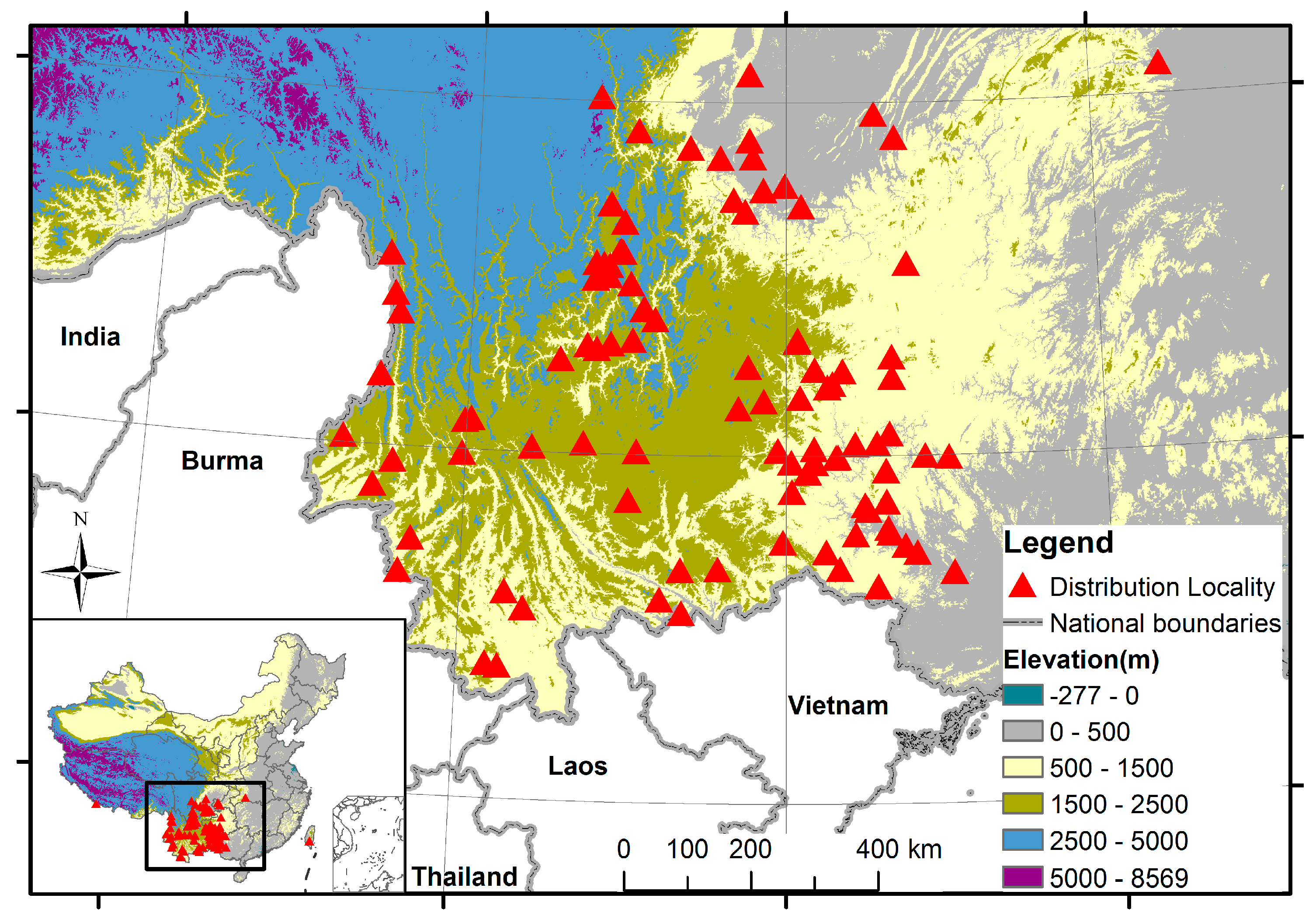
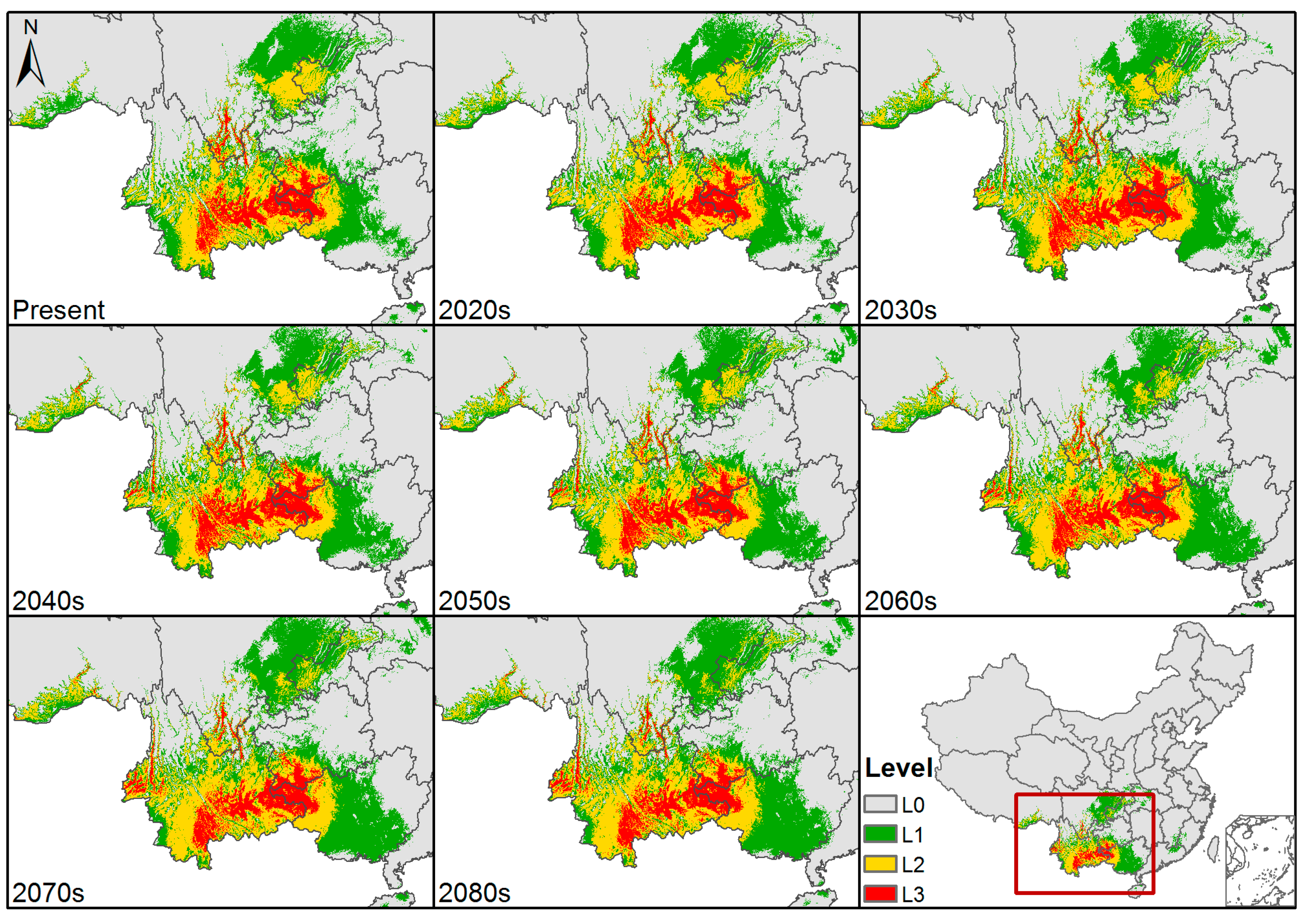
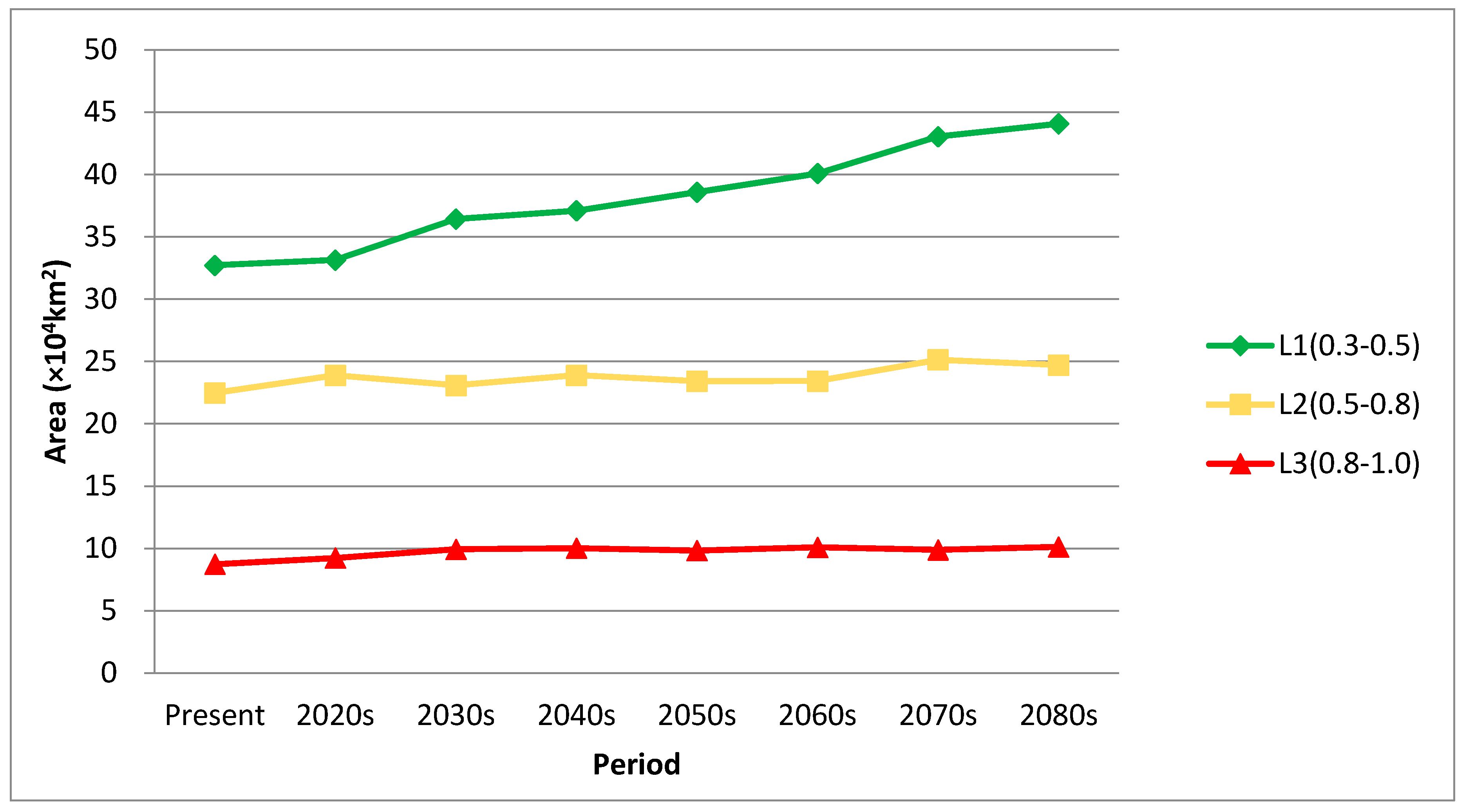
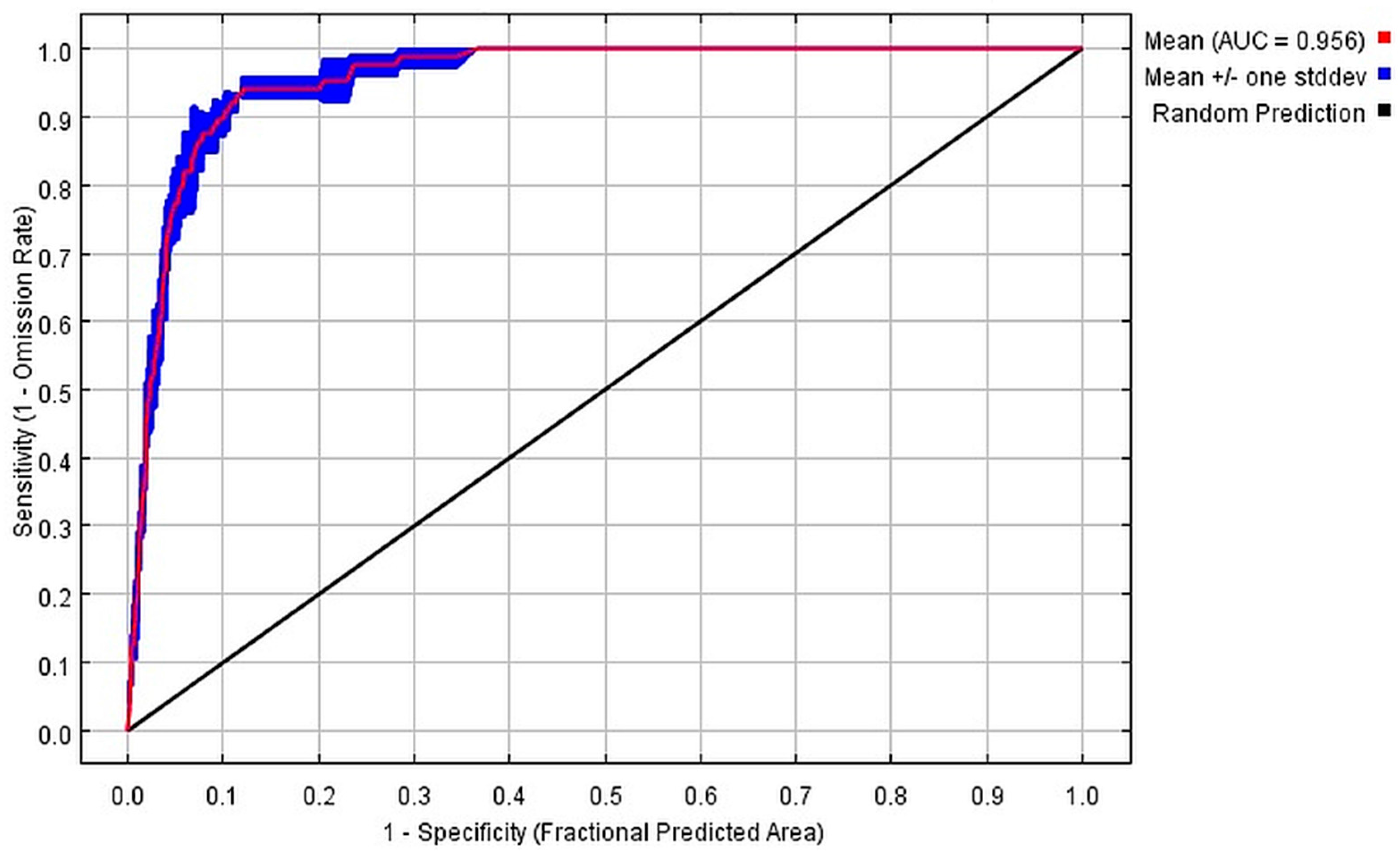
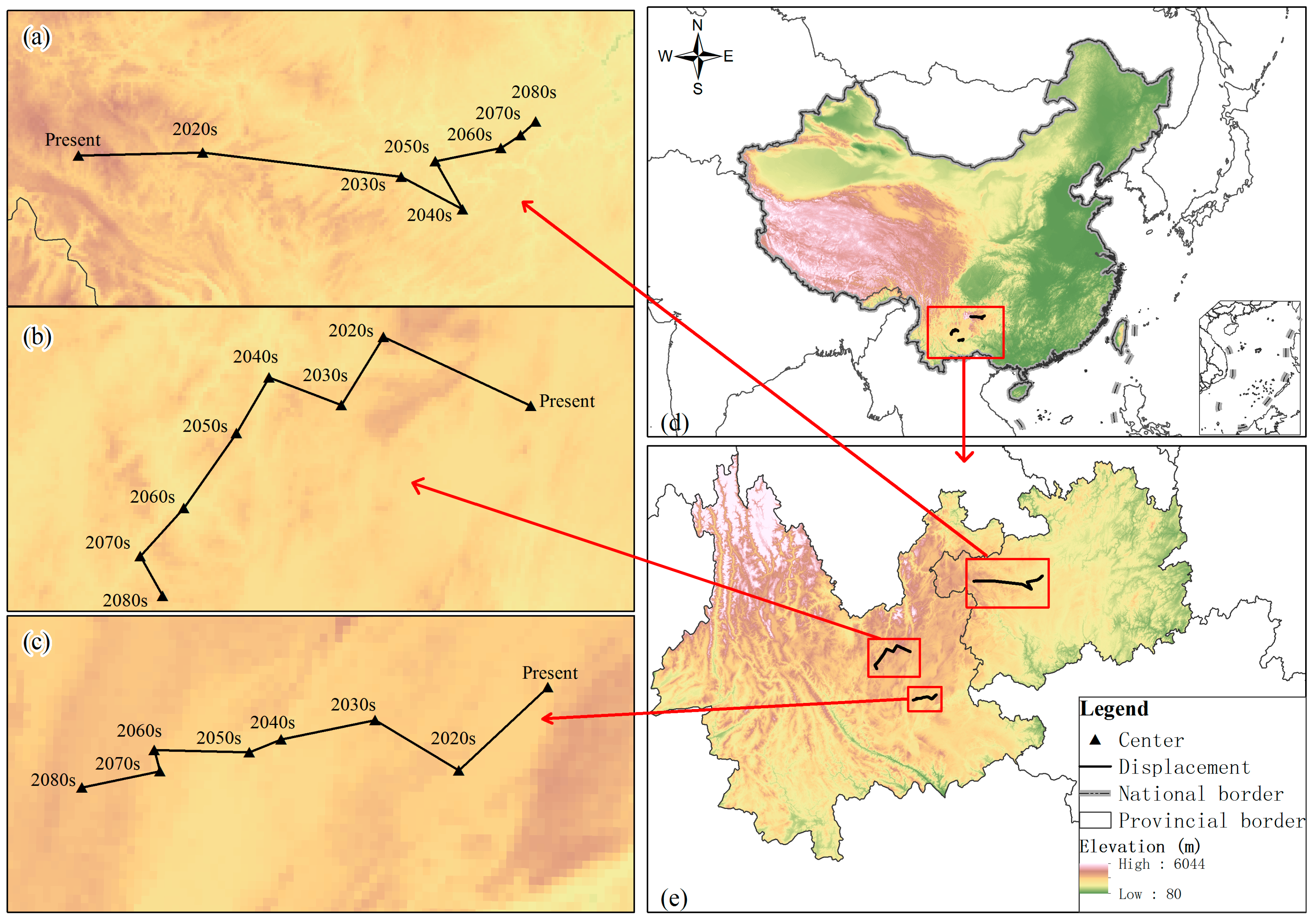
| Variables | Description | Variables | Description |
|---|---|---|---|
| BIO1 | Annual mean temperature | BIO14 | Precipitation of driest month |
| BIO2 | Mean diurnal range (Mean of monthly (maximum temperature—minimum temperature)) | BIO15 | Coefficient variation of precipitation |
| BIO3 | Isothermality [(BIO2/BIO7) × 100] | BIO16 | Precipitation of wettest quarter |
| BIO4 | Temperature seasonality(standard deviation × 100) | BIO17 | Precipitation of driest quarter |
| BIO5 | Maximum temperature of the warmest month | BIO18 | Precipitation of warmest quarter |
| BIO6 | Minimum temperature of the coldest month | BIO19 | Precipitation of coldest quarter |
| BIO7 | Temperature annual range (BIO5–BIO6) | TmeanX | Mean temperature of the Xth month in a year |
| BIO8 | Mean temperature of the wettest quarter | Tmax | Maximum temperature of the Xth month in a year |
| BIO9 | Mean temperature of the driest quarter | Tmin | Minimum temperature of the Xth month in a year |
| BIO10 | Mean temperature of the warmest quarter | Prec | Precipitation of the Xth month in a year |
| BIO11 | Mean temperature of the coldest quarter | Alt | Altitude |
| BIO12 | Annual precipitation | Asp | Aspect |
| BIO13 | Precipitation of the wettest month | Slp | Slope |
| Variable | ENFA | Percent Contribution | Jackknife | Weighted Average | Rank |
|---|---|---|---|---|---|
| Tmax3 | 3 | 3 | 1 | 2.3 | 1 |
| Tmean1 | 4 | 2 | 2 | 2.7 | 2 |
| Tmax1 | 2 | 1 | 6 | 3.0 | 3 |
| Tmax2 | 1 | 9 | 4 | 4.7 | 4 |
| BIO11 | 5 | 7 | 5 | 5.7 | 5 |
| Tmean2 | 6 | 10 | 3 | 6.3 | 6 |
| Tmean12 | 8 | 6 | 7 | 7.0 | 7 |
| Tmax12 | 7 | 5 | 10 | 7.3 | 8 |
| BIO6 | 9 | 4 | 9 | 7.3 | 8 |
| Tmin1 | 10 | 8 | 8 | 8.7 | 10 |
© 2017 by the authors. Licensee MDPI, Basel, Switzerland. This article is an open access article distributed under the terms and conditions of the Creative Commons Attribution (CC BY) license (http://creativecommons.org/licenses/by/4.0/).
Share and Cite
Wang, C.; Lin, H.; Feng, Q.; Jin, C.; Cao, A.; He, L. A New Strategy for the Prevention and Control of Eupatorium adenophorum under Climate Change in China. Sustainability 2017, 9, 2037. https://doi.org/10.3390/su9112037
Wang C, Lin H, Feng Q, Jin C, Cao A, He L. A New Strategy for the Prevention and Control of Eupatorium adenophorum under Climate Change in China. Sustainability. 2017; 9(11):2037. https://doi.org/10.3390/su9112037
Chicago/Turabian StyleWang, Chong, Huilong Lin, Qisheng Feng, Cangyu Jin, Aocheng Cao, and Lan He. 2017. "A New Strategy for the Prevention and Control of Eupatorium adenophorum under Climate Change in China" Sustainability 9, no. 11: 2037. https://doi.org/10.3390/su9112037





